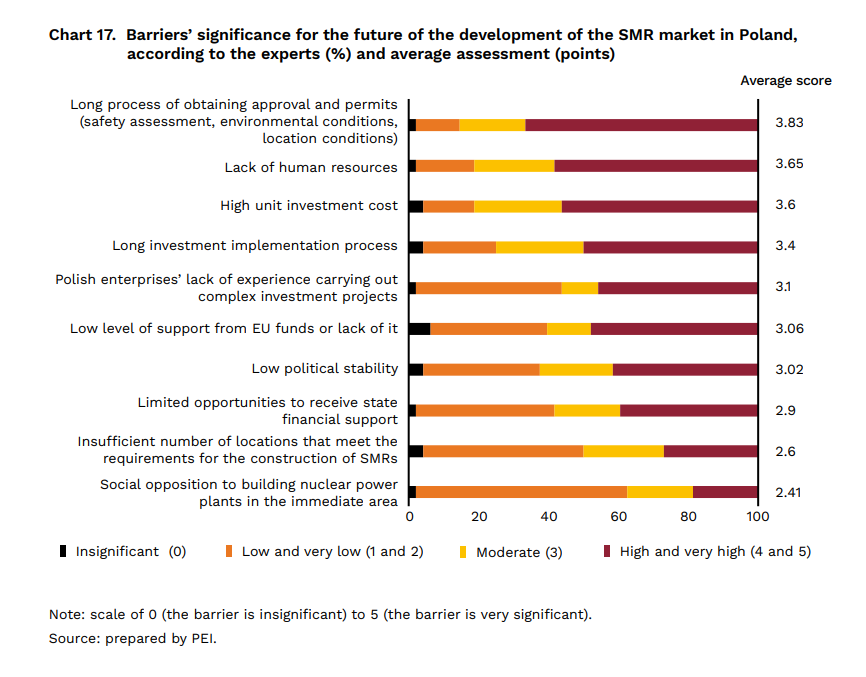SMRs will be used to produce heat for the largest Polish agglomerations by 2040
Published: 11/09/2023
Building Small Modular Reactors (SMRs) could be an important form of support for the energy transition. According to official announcements by manufacturers, over 100 SMRs are set to be built in Poland by 2040. Experts indicate that, apart from producing energy for industry, SMRs’ greatest potential may lie in the production of system heat in the largest Polish agglomerations; for example, three reactors with a capacity of 900 MWt (300 MWe) could meet up to 80% of Warsaw's demand for system heat in 2040. At the same time, experts point out that — although they could play an important role in the decarbonisation process — building SMRs will not replace the need to invest in renewable energy and large-scale nuclear energy. These are the conclusions of the Polish Economic Institute’s report entitled Prospects for the use of SMRs in Poland’s energy transition, which analysed SMRs’ potential in the energy industry and the potential barriers to developing this technology.
SMR could support the decarbonisation of heating
According to the experts surveyed by the PEI, apart from producing electricity for industry, one of SMRs’ key roles will be producing system heat. According to 50% of the experts, SMRs will be used for this purpose before 2040. Meanwhile, 77% of the experts believe that they could even meet over 20% of the demand for district heat in large urban agglomerations in the future.
Poland remains one of the EU countries with the most developed district heating system. More than 40% of the 13.5 million households in Poland are connected to the heating network. It is also responsible for around a quarter of all the heat generated (including in industry). In the 53.5 GW of installed capacity in heating networks, coal remains the fundamental fuel (71% of total fuel consumption; around 14.5 million tonnes per year). One of the cities that could benefit significantly from the use of SMRs in the decarbonisation of heating is Warsaw. In 2020, the demand for system heat in the Polish capital amounted to 8.9 TWh; of this, as much as 90.7% was produced by heating plants that use hard coal. In the future, the demand for heating in Warsaw could even exceed 14 TWh. Installing three reactors with a capacity of 900 MWt (300 MWe) in the network could meet up to 81% of Warsaw’s annual heating demand in 2040 in the cogeneration model, while boosting electricity production in the months when demand for heating falls.

“According to most of the experts surveyed, using SMRs in district heating in Poland will be extremely important for the energy transition. This is due to the urgent need to decarbonise heating, most of which is currently based on coal combustion. At the same time, competition in the form of alternative technologies is much lower here than in electricity production. This means that the use of SMRs to produce heat for both municipal and industrial needs could be their most important application,” says Adam Juszczak, an adviser on the PEI’s climate and energy team.
Barriers to the development of SMRs
Asked which barrier could hamper the installation of SMRs, experts cited the early stage of the technology’s development the most often. At the moment, advanced pilot projects only exist in China and Russia. Postponing the completion of the first SMRs increases the cost of the installed power, which could make the investment less attractive, compared to other solutions. Among the other barriers to the development of SMRs in Poland, experts also cited the long process of obtaining consent and permits for building the reactors, staff shortages, and the investments’ high unit cost.

If SMRs are to be produced in series, international requirements need to be developed, including when it comes to the licensing and technology assessment processes. Meanwhile, it is necessary to start selecting the location of the first reactors and the procedure for issuing a decision on environmental conditions as soon as possible. State subsidies or guarantees covering some of the cost of SMRs may be needed. Staff shortages in the field of nuclear energy are also a major problem. We have gone from being a country that had no real nuclear plans to one where three power plants based on large reactors and dozens of small reactors are set to be built over the same period. Close cooperation with universities of technology, aiming to expand courses educating nuclear specialists, is therefore critical,” adds Juszczak.
Poles accept the use of nuclear energy
Public support for using the latest nuclear technologies to generate electricity in Poland is at 84%, the highest result among the countries surveyed. This is 15 pp higher than in France and Sweden (69% support) and 23 pp higher than in the US.
***
The Polish Economic Institute is a public economic think-tank dating back to 1928. Its research primarily spans macroeconomics, energy and climate, the world economy, economic foresight, the digital economy and behavioural economics. The Institute provides reports, analyses and recommendations for key areas of the economy and social life in Poland, taking into account the international situation.
Media contact:
Ewa Balicka-Sawiak
Press spokesperson
T: +48 727 427 918
E: ewa.balicka@pie.net.pl
Category: Report / Reports 2023





